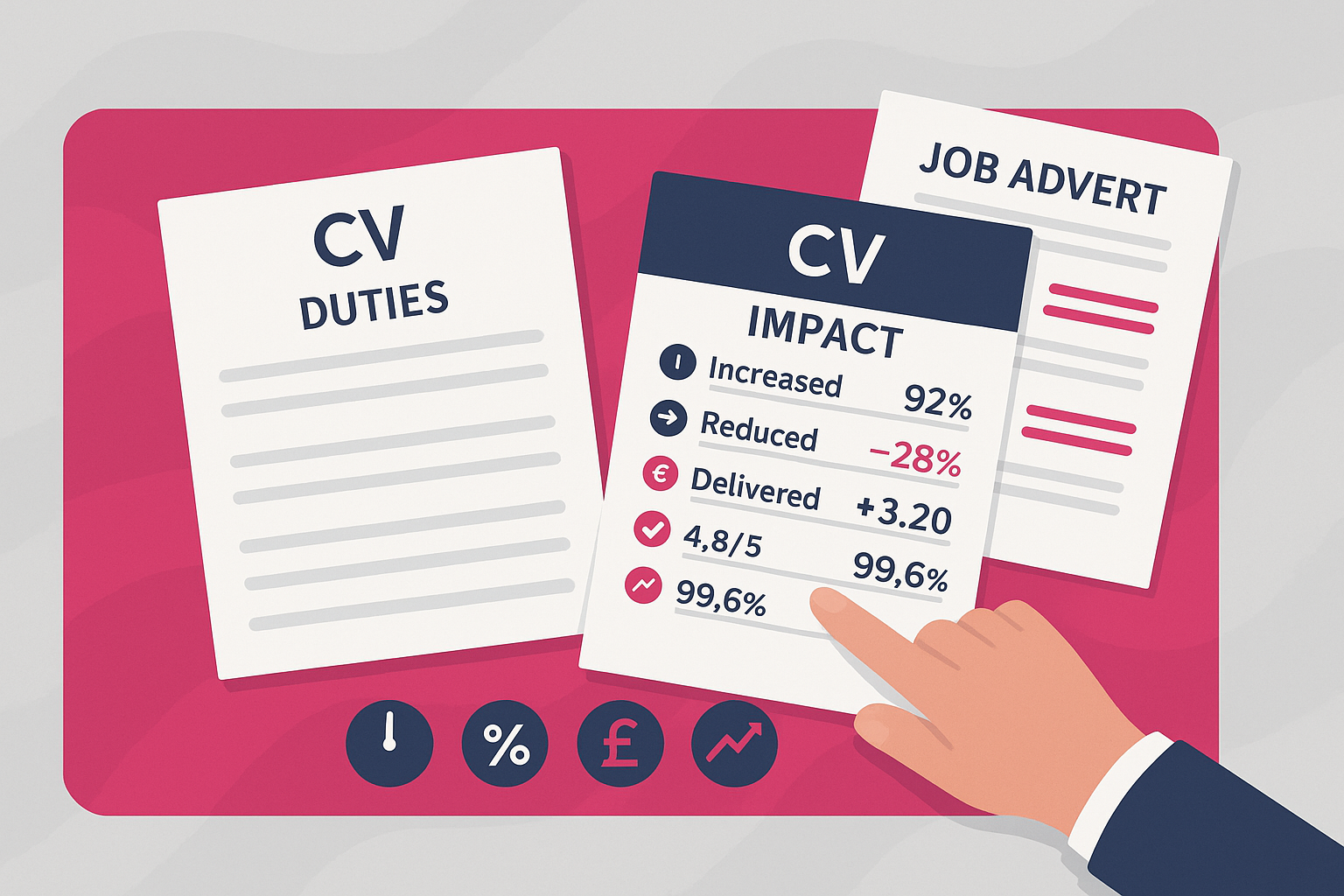
Write Impact Statements Not Duties on Your CV to Get Hired
Stop Listing Duties. Start Proving Impact
Still listing duties on your CV? That is why it gets ignored. Recruiters skim for 7 to 10 seconds. Duties blur everyone into the same grey mass. Impact statements cut through by proving value. If you want interviews, write outcomes, not job descriptions. Here is the definitive, tactical guide to do it now.
What Is an Impact Statement?
An impact statement is a one-line achievement that shows the value you delivered. It fuses context, action and a measurable result. It answers three questions fast. What was the problem. What did you do. What changed because of you.
Compare these two bullets.
- Duties: Responsible for customer enquiries.
- Impact: Resolved an average of 35 customer enquiries per day with a 92% first-contact resolution rate, cutting queue times by 28% in three months.
The second bullet is specific, measurable and valuable. It earns interviews.
Why Listing Duties Fails
- Duties are generic. They describe the role, not your performance.
- Duties do not signal scale, quality or speed. No sense of difficulty or outcome.
- Duties make you interchangeable. Achievements make you scarce.
- Duties do not map to business goals. Recruiters hire problems solved, not tasks performed.
- Duties waste your top third of the page. That is where impact must live.
Core Formulas That Work
Use a simple structure. Do not complicate this.
1) CAR Formula
- Challenge: The situation or problem.
- Action: What you did.
- Result: The measurable change.
Example: Cut onboarding time from 14 to 7 days by building a step-by-step checklist and automating status emails, reducing dropouts by 22%.
2) XYZ Formula
- Achieved X, by doing Y, measured by Z.
Example: Increased weekly bookings by 18% by redesigning the online form and simplifying error messages, measured through Google Analytics funnels.
3) Scope-Action-Outcome
- Scope: Volume, scale, budget, customers, locations.
- Action: The specific behaviour, tool or method.
- Outcome: A number or quality improvement.
Example: Managed a 450 SKU stockroom and introduced daily cycle counts that cut stock discrepancies from 6% to 1.8% within eight weeks.
Templates You Can Copy Today
- Improved [metric] by [number or percentage] by [action] which resulted in [business outcome].
- Delivered [result] across [scope] by [tool or method], reducing [negative metric] by [percentage or time].
- Completed [project] [faster or cheaper] by [action], saving [time or cost] and improving [quality metric].
Quantify Your Impact When You Lack Perfect Numbers
You can always measure something. Use directional figures, ranges and proxies. Stay honest and defensible.
Metrics You Can Use
- Volume: number of customers served per day, orders picked per hour, tickets resolved per week.
- Speed: turnaround time, time to respond, time to onboard, delivery time.
- Quality: error rate, first-time-right, satisfaction score, returns rate, compliance rate.
- Cost and savings: budget managed, cost avoided, waste reduced, mileage saved.
- Growth: conversion rate, sign-ups, upsells, click-through rate, attendance, adoption rate.
- Reliability: uptime, missed deadlines, backlogs cleared, SLA adherence.
- Scope: number of sites, regions, stakeholders, systems, files, records.
- Safety and risk: incidents prevented, near misses, audit issues closed.
- People: team size supported, colleagues trained, volunteers coordinated.
- Frequency: daily, weekly, monthly averages that show cadence.
When Exact Numbers Are Unknown, Use Credible Ranges
- About, approximately, roughly, more than, less than. Example: Processed approximately 120 applications per week with zero missed deadlines over 6 months.
- Before versus after. Example: Cut average response time from roughly 4 hours to under 45 minutes.
- Ratios. Example: Supported a team of 12 across two sites with one shared calendar and maintained 100% coverage.
Translate Common Duties Into Impact Statements
Retail Assistant
- Duty: Stocked shelves and assisted customers.
- Impact: Replenished high-demand aisles every two hours and reduced out-of-stock incidents by 35% in peak season, lifting average basket value by £3.20.
Customer Service
- Duty: Answered calls and emails.
- Impact: Handled 60 to 80 contacts per shift with 95% SLA adherence and achieved a 4.8 out of 5 post-contact rating over 4 months.
Administrative Assistant
- Duty: Managed calendars and files.
- Impact: Coordinated 50 to 70 weekly appointments across three managers and introduced naming conventions that cut file search time by 40%.
Hospitality
- Duty: Served tables and took payments.
- Impact: Managed a 10-table section during weekend peak and increased covers per hour by 15% by pre-bussing and batching card payments.
Warehouse Operative
- Duty: Picked and packed orders.
- Impact: Averaged 110 picks per hour at 99.6% accuracy and piloted a new bin labelling system that reduced mis-picks by 30%.
Internship
- Duty: Assisted with social media.
- Impact: Produced 12 short-form videos that increased follower growth by 22% and lifted average engagement rate from 1.9% to 3.4% in eight weeks.
Call Centre
- Duty: Followed scripts and logged cases.
- Impact: A-B tested script tweaks that cut call handling time by 35 seconds while maintaining a quality score above 90%.
University Project
- Duty: Completed group assignment.
- Impact: Led a 4-person Agile sprint to deliver a prototype two weeks early, scoring 78% and presenting to 25 peers and faculty.
Volunteering
- Duty: Helped at community events.
- Impact: Coordinated 20 volunteers for a local careers fair attended by 350 students and secured five new employer partners for the next event.
Retail Cashier
- Duty: Operated the till.
- Impact: Balanced a daily float of £1,500 with zero discrepancies across six months and processed peak queues in under 5 minutes by triaging quick transactions.
IT Support
- Duty: Reset passwords and fixed basic issues.
- Impact: Closed 25 to 35 tickets per day with 92% first-time fix and built a 10-article FAQ that reduced repeat tickets by 18%.
Align With the Job Advert and ATS
Impact without alignment misses the target. Your bullets must map to the role and include the right keywords.
- Extract keywords from the job advert. Skills, tools, methods and outcomes. Mirror the employer’s language.
- Group achievements under the role that used the same tools or outcomes the advert emphasises.
- Prioritise bullets that show the top three outcomes the employer cares about. Revenue, speed, quality, customer satisfaction, compliance.
- Include tools and frameworks as part of the action. Example: automated with Excel, Power Query, SQL, Zendesk, Salesforce, Canva, Python, Power BI.
- Keep bullets tight. One to two lines. One idea per bullet.
- Lead with an active verb. Increased, reduced, delivered, created, automated, streamlined, negotiated, trained, analysed, designed, built, improved.
Formatting Rules That Keep You Credible
Placement and Density
- Put impact bullets in the top half of page one. That is the decision zone.
- 3 to 6 bullets for your most recent role. 2 to 4 for earlier roles.
- Remove filler bullets with weak or overlapping value.
Verbs and Tense
- Use past tense for completed work. Use present tense for your current role.
- Avoid weak verbs. Helped, responsible for, assisted, involved in. Replace with precise actions.
Numbers and UK Style
- Use the UK format. £, per cent, dates as month year. Example: Jan 2024, £120,000, 12 per cent.
- Lead with the outcome metric if it is strong. Use bold only if permitted by your CV template.
Confidentiality and Compliance
- Do not reveal sensitive data. Convert absolute numbers to percentages when needed.
- Be honest. You must be able to explain every metric in interview.
Readability
- Use consistent bullet markers and spacing.
- Avoid long run-on sentences. Cut fluff words. Very, extremely, successfully.
- Avoid jargon unless it matches the advert.
How to Build Your Impact Bank
Stop guessing under pressure. Capture wins weekly.
- Create a running log. Date, task, tool, outcome, metric, stakeholder.
- Scan emails and messages for thank you notes and before-after numbers.
- Export reports from systems you use. Pull average handling time, conversion, volumes, backlog, satisfaction.
- Ask for feedback with numbers. What changed after your change.
- Keep screenshots of dashboards and graphs to refresh your memory.
- Tag achievements by skill. Problem solving, communication, data, teamwork, initiative.
- Revisit end-of-month or end-of-quarter summaries to collect evidence.
- Turn each item into a one-line CAR bullet. Edit for precision.
Impact Statements for First-Time Job Seekers
No experience is not an excuse. You have results. Use study, projects, volunteering, side work and daily life with professional framing.
- Coursework: Built a 3,000-word report using Excel analysis of 1,200 rows of data and presented insights that improved group mark to 74%.
- Student society: Grew membership from 18 to 46 in one term by running weekly events and streamlining sign-ups with a QR process.
- Part-time job: Upsold meal deals to 1 in 5 customers on average, adding an estimated £150 per shift in revenue.
- Hackathon: Designed a prototype in 24 hours that won second place out of 16 teams. Pitched to a panel of five judges.
- Caring responsibilities: Coordinated medication and appointments across two family members, maintained error-free records and reduced missed appointments to zero across 9 months.
- Freelance or gigs: Delivered 12 logo drafts within 72 hours across three clients and secured 2 repeat contracts through on-time delivery and clear revisions.
Advanced Tactics That Amplify Impact
- Pair outputs and outcomes. Output is what you made. Outcome is what changed. Example: Built a dashboard, which cut manual reporting time by 6 hours per week and improved forecast accuracy by 10 per cent.
- Stack metrics. Combine quality and speed. Example: Increased call throughput by 12 per cent while keeping customer satisfaction above 4.7 out of 5.
- Convert soft skills into hard outcomes. Example: Calmed an upset customer and prevented cancellation worth approximately £480 ARR.
- Timebox achievements. Example: Achieved [result] in [timeframe], which shows pace.
- Add scale to routine tasks. Example: Processed 200 CVs per day across 3 hiring managers with 100 per cent data accuracy.
- Show repeatability. Example: Maintained 98 per cent on monthly quality audits for four consecutive quarters.
The 10-Point Impact Checklist
- Does it start with a strong verb.
- Does it show scope or context.
- Is the action specific and named.
- Is there a number, rate or percentage.
- Is the business outcome clear.
- Is it aligned to the target job.
- Is it short and scannable.
- Is it honest and defensible.
- Does it avoid jargon and filler.
- Would a hiring manager care about this.
30-Minute Rewrite Plan
You do not need a full day. Get a better CV in half an hour.
- Minutes 0 to 5: Pick one target job and highlight five keywords that matter most.
- Minutes 5 to 10: Choose your top role. Delete every duty-based bullet.
- Minutes 10 to 20: Write five new CAR bullets that map tightly to the target job. Add a number to each.
- Minutes 20 to 25: Edit for clarity and length. One to two lines per bullet.
- Minutes 25 to 30: Proofread aloud. Check tense, numbers, and alignment with the advert.
Before and After Examples You Can Copy
Admin before: Responsible for scheduling meetings.
Admin after: Scheduled 35 to 50 meetings per week across three time zones and cut clashes by 90 per cent by enforcing buffer rules and colour coding.
Sales before: Contacted leads and updated CRM.
Sales after: Converted 21 per cent of qualified leads by launching a two-touch follow-up sequence and maintained CRM hygiene at 98 per cent completeness.
Operations before: Helped with inventory.
Operations after: Introduced weekly cycle counts across 400 items and reduced shrinkage from 5 per cent to 2.1 per cent in one quarter.
Marketing before: Managed Instagram account.
Marketing after: Grew followers from 1,200 to 1,950 in 10 weeks and lifted average reach per post by 40 per cent by shifting to educational carousels.
IT before: Assisted users.
IT after: Resolved 85 per cent of walk-ups within 15 minutes and documented fixes that cut repeat visits by 25 per cent in two months.
Common Mistakes to Avoid
- Inflating numbers beyond credibility. Interviewers will test them.
- Hiding outcomes at the end of a long sentence. Put numbers early.
- Mixing multiple ideas in one bullet. Split them.
- Repeating the same metric across bullets. Show range and breadth.
- Copying advert language without substance. Evidence beats buzzwords.
Putting It All Together on Your CV
- Professional summary: Add one or two top impact headlines that mirror the job. Example: Operations graduate who reduced stock errors by 64 per cent and cut dispatch times by 22 per cent.
- Experience section: Use impact bullets for each role. Highest impact first.
- Projects section: Add 3 to 5 bullets that show measurable outcomes.
- Skills section: List tools and frameworks you used in the actions.
- Education section: Include results. Grades, awards, leadership, competitions.
Why This Matters Beyond Hiring
Impact statements train you to think in outcomes. That mindset makes you valuable fast. It also makes managers’ lives easier because they can see where you will add value in week one. Meaningful work is about progress. Show you can deliver it.
Final Push
Write five impact statements today. Replace your top five duty bullets. Add numbers. Align to a target job. You will notice the difference in responses. Duties say you turned up. Impact states why you matter.
Next Steps
Want to learn more? Check out these articles:
Show You’re Job-Ready With No Experience: 10 Proven Tactics
Decode Job Adverts for Fit: The Practical Graduate's Guide
Build Interview Confidence with AI Mock Tools for Hiring
Check out our Advanced Employability Course for all the help you need to get your dream job, fast.


